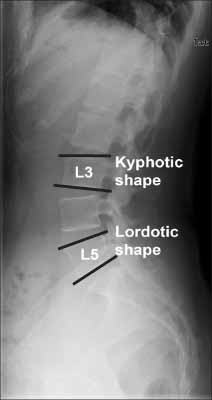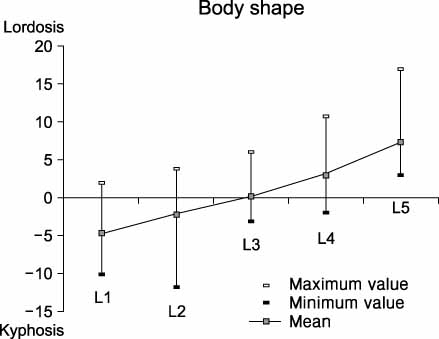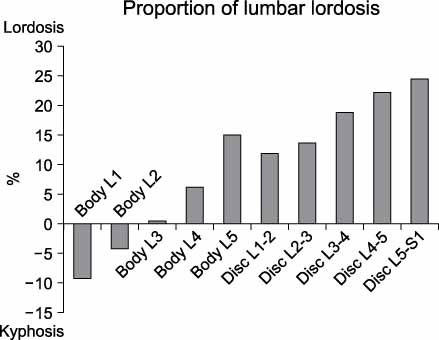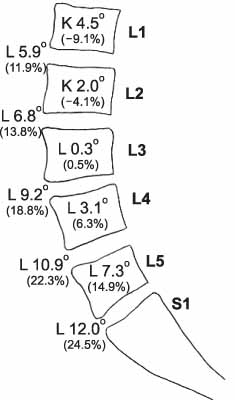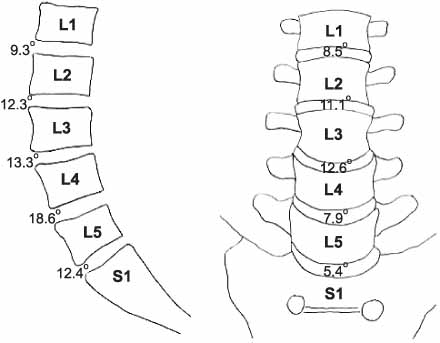J Korean Orthop Assoc.
2008 Oct;43(5):595-600. 10.4055/jkoa.2008.43.5.595.
Shape and Motion of Each Lumbar Segment in Normal Korean Adults
- Affiliations
-
- 1Department of Orthopaedic Surgery, College of Medicine, Chungbuk National University, Cheongju, Korea. ymkim@chungbuk.ac.kr
- KMID: 2186421
- DOI: http://doi.org/10.4055/jkoa.2008.43.5.595
Abstract
-
PURPOSE: By achieving informations about sagittal shape and motion of each lumbar segment in normal subjects, we tried to get the standards useful in management of spinal disorders and fractures.
MATERIALS AND METHODS
Thirty normal adults without any disorder on their back were adopted. L3 centered thoracolumbar (T-L) X-ray's including standing lateral, AP's in righ-tleft bending, and flexion- extension lateral were checked for each person. Cobb angles of each segment were measured. Statistical analysis was done for comparison by gender and correlation of each factors.
RESULTS
Body shape of upper lumbar vertebrae was kyphotic but caudal bodies are changed into lordotic gradually. Disc angle was lordotic in all the discs. Segmetal motion in sagittal plane was greatest at L4-L5 (18.6degrees). However, segmental motion at coronal plane was largest at L3-L4 (12.6degrees).
CONCLUSION
We achieved Korean standard of shape and motion of each lumbar segment. Proportion of each factor contributing to total lumbar lordosis was evaluated also.
Keyword
MeSH Terms
Figure
Cited by 1 articles
-
Analysis of Risk Factors and Surgical Results of Lumbar Adjacent Segment Disease
Whoan Jeang Kim, Jong Won Kang, Byoung Sub Kam, Sung Il Kang, Won Cho Kwon, Kun Young Park, Jae Guk Park, Hwan Il Sung, Won Sik Choy
J Korean Soc Spine Surg. 2010;17(2):74-81. doi: 10.4184/JKSS.2010.17.2.74.
Reference
-
1. Anderson GB, Murphy RW, Ortengren R, Nachemson AL. The influence of backrest inclination and lumbar support on lumbar lordosis. Spine. 1979. 4:52–58.
Article2. Bernhardt M, Bridwell KH. Segmental analysis of the sagittal plane alignment of the normal thoracic and lumbar spines and thoracolumbar junction. Spine. 1989. 14:717–721.
Article3. Fernand R, Fox DE. Evaluation of lumbar lordosis. A prospective and retrospective study. Spine. 1985. 10:799–803.4. Gelb DE, Lenke LG, Bridwell KH, Blanke K, McEnery KW. An analysis of sagittal spinal alignment in 100 asymptomatic middle and older aged volunteers. Spine. 1995. 20:1351–1358.
Article5. Hansson T, Bigos S, Beecher P, Wortley M. The lumbar lordosis in acute and chronic low-back-pain. Spine. 1985. 10:154–155.6. Jackson RP, McManus AC. Radiographic analysis of sagittal plane alignment and balance in standing volunteers and patients with low back pain matched for age, sex, and size. A prospective controlled clinical study. Spine. 1994. 19:1611–1618.7. Kim YM, Kim DS, Choi ES, et al. Results of non-fusion method in thoracolumbar and lumbar spinal fractures. J Korean Soc Spine Surg. 2005. 12:132–139.
Article8. Lee JM. The measurement of normal thoracic kyphosis in Korean. J Korean Orthop Assoc. 1982. 17:772–778.
Article9. Stagnara P, De Mauroy JC, Dran G, et al. Reciprocal angulation of vertebral bodies in a sagittal plane: approach to references for the evaluation of kyphosis and lordosis. Spine. 1982. 7:335–342.
Article10. Suk SL, Lee CS, Lo M, Kim WJ. Normal segmental sagittal angle of the lower dorsal and lumbosacral spine in Korean adult. J Korean Orthop Assoc. 1989. 24:237–244.
Article11. Wood KB, Kos P, Schendel M, Persson K. Effect of patient position on the sagittal-plane profile of the thoracolumbar spine. J Spinal Disord. 1996. 9:165–169.
Article
- Full Text Links
- Actions
-
Cited
- CITED
-
- Close
- Share
- Similar articles
-
- Change of Segmental Motion After Lumbar Posterolateral Fusion
- A Study of Lumbar Spinal Canal Using Computerized Axial Tomogram in Korean Adults
- Development of Spine Motion Analyzer and Comparison of Motion in Normal and Lumbar Fusion Cases
- Combined Instrumentation with the Soft and Rigid Stabilizer in Degenerative Lumbar Disorders
- Segmental Instability in Posterolateral Lumbar Spinal Fusion

